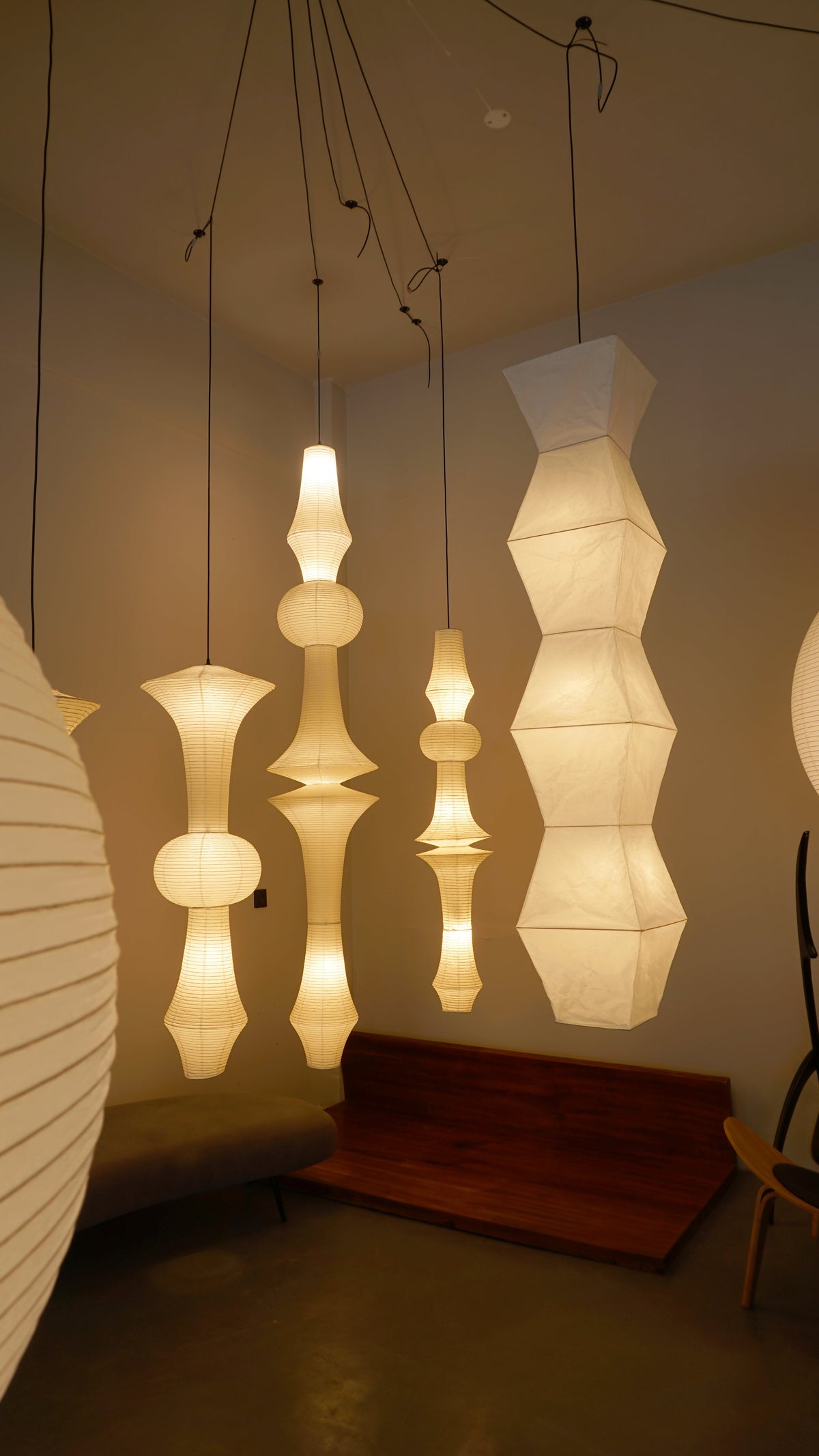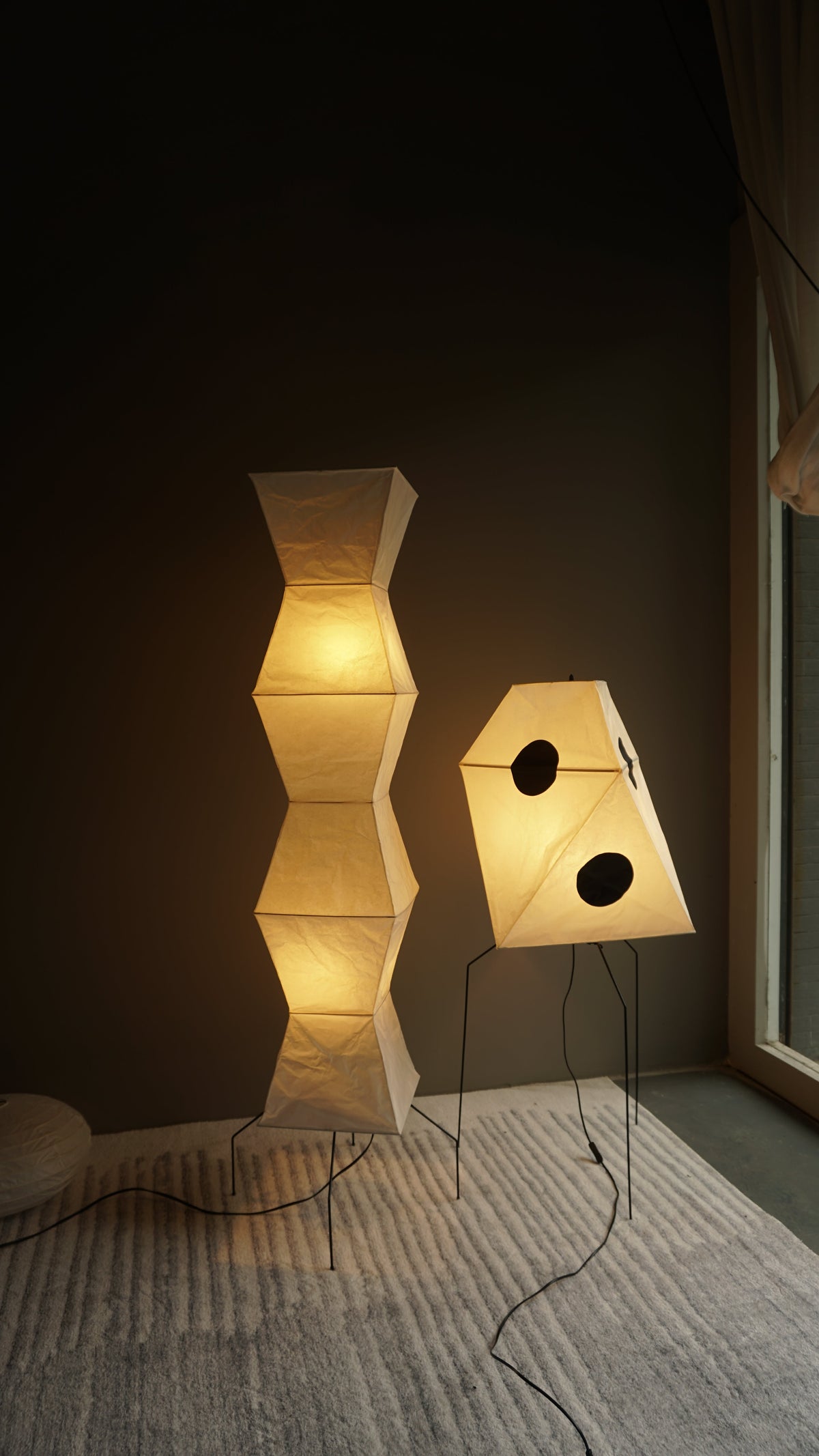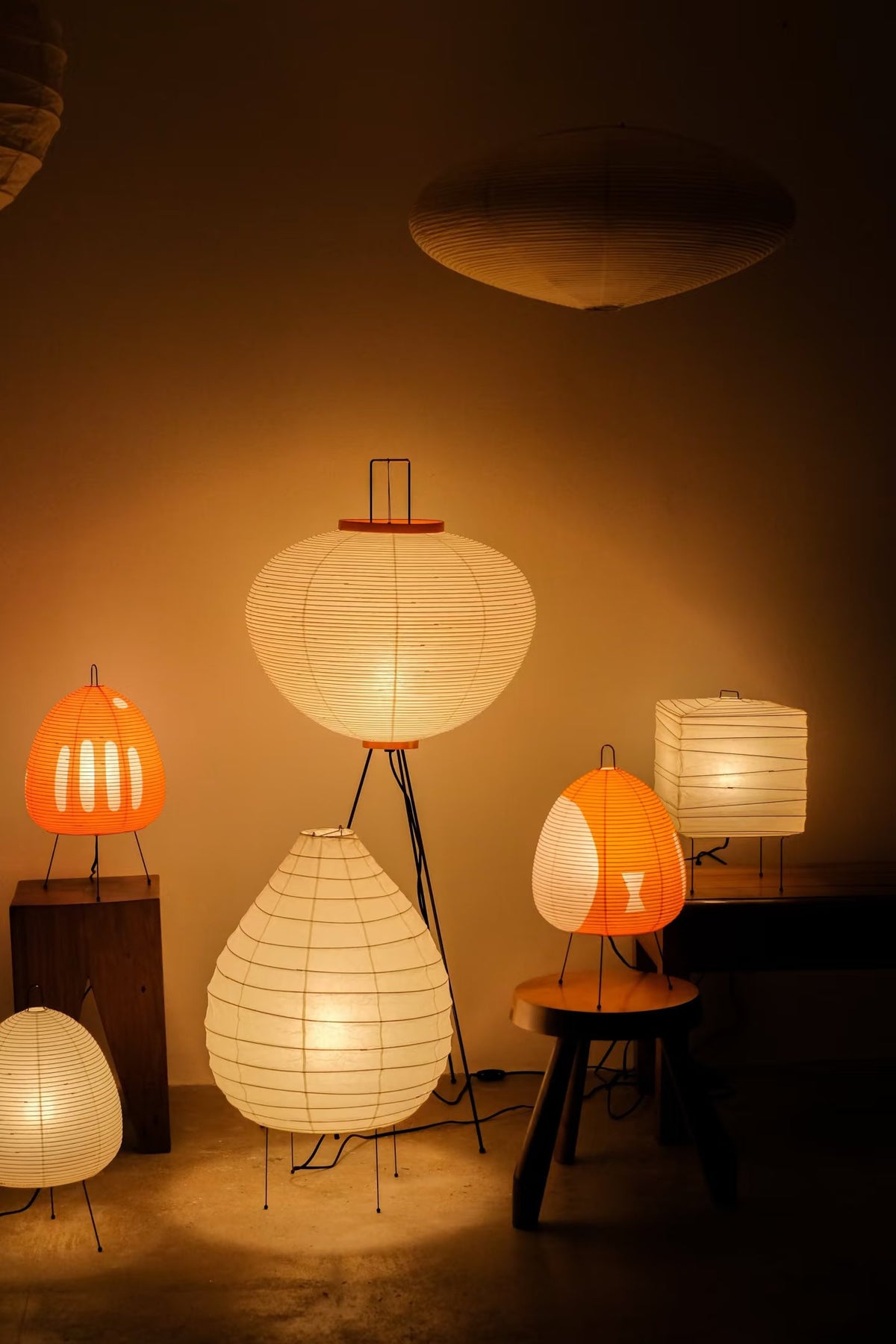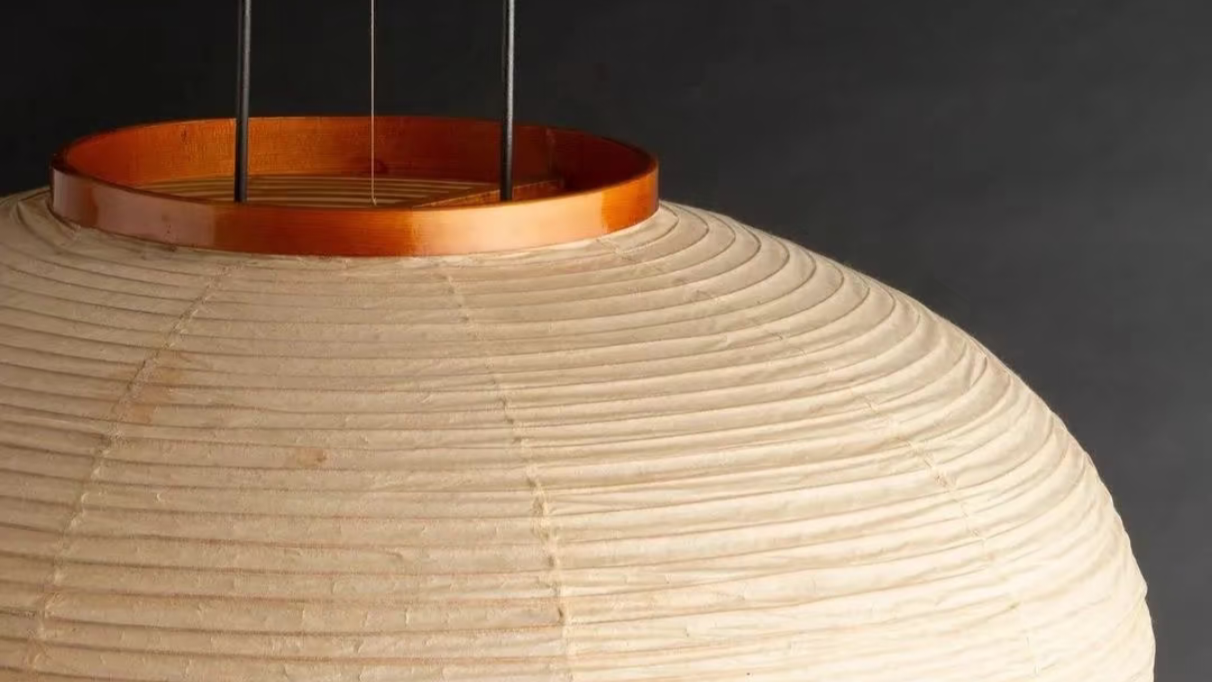Good placement can turn a lamp from “just a light” into the single thing that makes a living room feel finished. Below you’ll find practical, low-effort placement rules plus styling ideas that work whether you want a bright noguchi floor lamp for reading, a soft akari paper lamp for evenings, or both.
Quick rules of thumb (read this first)
-
Decide function first: Do you need task light (reading), ambient light (overall brightness), or accent light (mood)? Where you place the lamp follows that choice.
-
Layer your lights: One lamp rarely does everything. Combine a bright uplight/torchiere or ceiling light with a soft Akari-style floor lamp for mood.
-
Mind scale & sightlines: Taller lamps work behind seating; lower lamps work by chairs or beside side tables. Keep lamps from blocking sightlines into the room.
-
Leave room to walk: Keep clear pathways — don’t place stands where people naturally pass.
Best spots to put a floor lamp in the living room
1) Next to a reading chair — the classic choice
Place your lamp to the side and slightly behind the chair, so the light comes over your shoulder and onto the page without casting a shadow. If you use a small side table, the lamp can be directly beside it.
-
Lamp type: adjustable swing-arm or directional head for focused light; a noguchi floor lamp or akari 20n lamp works if it has a reading arm or if you add a task lamp nearby.
-
Bulb tip: 400–800 lumens for reading; 2700K–3000K for comfortable warm light; CRI 90+ if you want true color.
Why it works: Focused task light + soft ambient light = cozy, strain-free reading.
2) Behind the sofa — for even ambient glow
Tucking a torchiere or an Akari-style tall lamp behind a sofa provides indirect light that bounces off the ceiling and fills the room without glare.
-
Lamp type: torchiere, tall akari floor lamp (like models referenced with tags such as AKARI 24n or akari 22n proportions), or a slim uplight.
-
Placement distance: 12–18 inches from the sofa back to avoid being knocked and to let light spread.
-
Bulb tip: choose bulbs totaling 1500–3000 lumens for whole-room fill if this is your main ambient source.
Why it works: Bounce light feels natural and keeps the room even — great in darker living rooms.
3) In an empty corner — banish dark spots
Corners accumulate shadow. A tall paper-shade floor lamp, especially an Akari-style piece, softens a corner and visually opens the room.
-
Lamp type: tall Akari-style lantern or column floor lamp (think vertical N series silhouettes).
-
Styling: angle the lamp slightly toward the room for a more even spread.
-
Bonus: Add a plant or a small chair to create a cozy corner nook.
Why it works: Corners are easy wins — one lamp removes gloom and adds interest.
4) Next to the TV — reduce eye-strain
A low, soft lamp placed behind or beside the TV reduces eye fatigue by balancing screen contrast. Use a dimmable lamp with warm color temp.
-
Lamp type: floor lamp with a shaded head or an Akari paper lamp (avoid harsh directional light that reflects on the screen).
-
Placement: behind the console, slightly offset from the screen center.
Why it works: Balanced ambient light prevents your eyes from overworking in a dark room while watching.
5) Over a sideboard or console table — ambience & display
A floor lamp with an upward diffuser near a console can highlight decorative items and create a display area.
-
Lamp type: angled uplight or a slim Akari-style lamp that reads like a sculpture.
-
Styling tip: layer with small table lamps or picture lights for museum-like effect.
Why it works: It turns a storage area into a purposeful vignette.
Where not to put a floor lamp
-
In the middle of a walkway or where your knees/feet hit it.
-
Too close to drapery or flammable textiles (leave safety clearance).
-
Directly in line with a TV if it creates reflections.
-
Right in front of a window where it competes with daylight and blocks a view.
Style tips: match lamp style to room mood
Akari-style paper floor lamp (Noguchi-inspired)
-
Best for: soft ambient glow, hygge vibes, bedrooms and living rooms where mood matters.
-
Why: washi-like paper diffuses light evenly and creates lovely shadows; pieces like akari 1A, AKARI 24n–style forms act as living sculptures.
Noguchi floor lamp or sculptural stands
-
Best for: design-forward spaces where the lamp is both art and light.
-
Why: sculptural frames and soft shades combine function and statement.
Bright task/torchiere lamps
-
Best for: large dark rooms needing actual brightness.
-
Why: uplight or multiple heads provide the lumen output you may need.
Mixing a soft Akari lamp with a bright torchiere is often the best balance: mood + function.
Bulb, lumen and height recommendations (practical numbers)
-
Living room ambient target: 1500–3000 total lumens. If you rely on one lamp for ambient light, aim for the upper range.
-
Reading task light: 400–800 lumens focused near the reading area.
-
Color temperature: 2700K–3000K for warm, cozy; 3000K–3500K if you need slightly cooler task clarity.
-
Height guidelines: Floor lamps typically stand 58–66 inches tall. Place the light source higher than eye level when seated to avoid glare (about 60–66" gives good clearance). For reading arms, the light should sit ~40–48 inches above the floor when seated.
How to layer a lighting plan around your floor lamp
-
Base layer (ambient): ceiling light, recessed cans or a torchiere.
-
Mid layer (floor/table lamps): Akari-style floor lamp for soft glow + reading lamp for tasks.
-
Accent layer: picture lights, LED strip under shelves, or small table lamps.
A typical living room might use one torchiere + one Akari floor lamp + one reading lamp to cover all bases.
Styling examples (copy-paste setups)
Cozy two-seater living room (small/medium):
-
Place an Akari floor lamp in the corner behind a loveseat (soft warm light).
-
Add a swing-arm reading lamp beside the main chair.
-
Use dimmable bulbs so you can drop to low levels for evenings.
Large open plan living room (dark space):
-
Put a torchiere behind the main sofa for broad ambient light.
-
Place two Akari-style lanterns (one in a corner, one near the reading spot) for mood.
-
Add a floor lamp with multiple heads near the TV for directional tasks.
FLOOR LAMPS FOR YOU:https://captainsbamboo.com/collections/floor-lamps
-
Quick placement checklist (printable)
-
What’s the lamp’s main job? (ambient / task / accent)
-
Are there clear walkways? (avoid trip hazard)
-
Will the lamp glare in the TV or in people’s eyes? (reposition or shade)
-
Is the lamp tall enough for seated eye level clearance? (60–66" recommended)
-
Bulb check: lumens, kelvin, CRI? (follow recommended numbers above)
-
Safety: secure base, cable run, and clearance from flammables.
-









0 comments